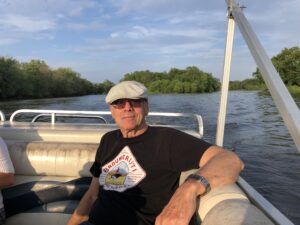Roger Bain’s memoir, Hardly Working” How I Found My Career and Kept My Soul, surprises and delights as it answers that thorny question: What do you want to be when you grow up? This coming-of-age tale, filled with a cast of colorful characters, is by turns thought provoking, amusing, and nostalgic as it describes the author’s quest for the American Dream, navigating as many twists and turns as Hulu’s Only Murders in the Building.
In the years immediately after college when most graduates are scrambling to reach the top of the food chain, Bain hatched a plan, “a life map where I would ‘retire’ at the beginning of adulthood. Of course, I would need to work, but as little as possible.” The candid description of the author’s unconventional journey does not disappoint.
Bain rivals participatory journalist George Plimpton in the variety of jobs he has held: golf caddy, drill press operator, Fuller Brush man, waterbed purveyor, itinerant hippie, song writer, store Santa, and cable TV adman, among others. He says: “Throughout my journey, I’ve always sought out that sweet spot: to have just enough without being possessed by my possessions, or by ‘the man,’ and to always have time for my own creative pursuits.” Ultimately, he draws upon his multi-faceted life experiences to establish a successful advertising agency that feeds his creative Muse while also paying the bills. Win-win.
Like other good memoirs, Hardly Working doesn’t simply chronicle the vicissitudes of Bain’s quixotic life; it also offers personal epiphanies: “I had a growing realization that my path was my own decision and to hell with expectations. . .” And “I knew I was lucky. I’d had a comfortable, trouble-free upbringing. But I wanted more from this life. I was on a quest, and the only way to discover what I was looking for was through experience.” And experiences he has had!
Hardly Working is well written and engaging. Unlike the spate of best-selling life stories later proven fraudulent, Bain’s account rings true, amply supplemented by photographs and an amazing level of detail. Fans of Bill Bryson’s The Life and Times of the Thunderbolt Kid and Ferris Bueller’s Day Off will appreciate its nostalgic look at life from the 1950s to the present. Devotees of music from bebop to hip hop will resonate with Bain’s recollections of music culture and his contributions to it. And those seeking to “find” themselves will have an entertaining guidebook of do’s and don’ts.
If you’re looking for a memoir that is both comical and substantive, grab a copy of Hardly Working. Then buckle up for a rollicking ride.
Nancy Walker, PhD, professor of psychology (retired)
Author of The Child Witness, Children’s Rights in the United States, and Lost Opportunities: The Reality of Latinos in the U.S. Criminal Justice System

